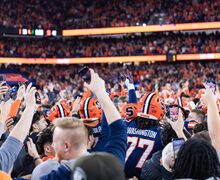Berman: Forget ‘rush worthy’ debate; storming court risky for players
In a marquee non-conference matchup in 1998, guard Juan ‘Pepe’ Sanchez of No. 7 Temple stood at the foul line for two shots with .5 seconds remaining, trailing No. 5 Michigan State by one point. Sanchez was already the catalyst in orchestrating an improbable comeback from a 10-point deficit with 3:36 remaining. Now he was at the foul line with the opportunity to finish the upset.
In the huddle during a timeout before the free throws, legendary coach John Chaney reportedly told Sanchez that once the Owls won, he wanted Sanchez off the court as quickly as possible.
Chaney knew what was coming.
The Temple students brimmed with excitement. If Sanchez made these shots, it would be an upset, and upsets in college basketball – particularly close ones – are often met with crazed fans charging the court like the running of the bulls in Pamplona.
Sanchez hit both shots. After the second shot, he fell backwards in glee. The fans, as Chaney expected, stormed the court. Chaney’s nightmare was realized.
On the bottom of the pile was Sanchez, the All-American point guard. As students celebrated on top of him, Sanchez’s ankle rolled. The diagnosis was a sprain. Sanchez missed the next game, when the Owls themselves were upset by intra-city rival Penn. And it didn’t improve much from there – the Owls lost their next three games. Even when Sanchez returned, he wasn’t entirely healthy. Suddenly a 4-0 season translated into a four-game losing streak – in large part because of the well-intentioned fans who rushed the court.
The Sanchez incident jumped to mind while talking to Donte Greene in a harmonious Syracuse locker room after the Orange topped Georgetown, 77-70, on Saturday, and the Syracuse student section charged the court.
‘It was fun before I got tackled,’ Greene said. ‘It was fun when I was jumping around, but [not] when I got tackled, and when a little kid is getting stepped on.’
In the days after the game, court rushing has become a topical issue among Syracuse fans. It’s filled blogs, message boards and airwaves. Most of the debate has centered on whether Saturday’s win was ‘rush worthy’ – that is to say, what makes one win worthy of rushing the court over another win? The critics insist rushing the court should be withheld for only the most unexpected upsets or most meaningful wins – with the Senior Night Stampede against Georgetown last season as an example.
The problem with those arguments is the critics try creating a code for fans. Part of the allure of college basketball is the fanaticism and pageantry surrounding the game. It’s what makes a big college basketball game so exciting. Anyone who was in the Carrier Dome Saturday can provide testimony on the intimacy of the atmosphere. When the Dome is pulsating and the Orange is clicking, it’s hard to find a more unique venue in college basketball. Trying to harness that passion is both counterproductive and sanctimonious.
There is nothing wrong with fans being fans – as long as it remains safe. That’s where this objection lies. It’s on a more practical level – the court rushing simply isn’t safe. And that’s not meant in a soccer mom sort of way, but instead from a basketball perspective. Any fan of Syracuse can tell you they’re fighting a depth problem. The last thing the Orange needs is Jonny Flynn and Donte Greene on the bottom of a pile of crazed, belligerent fans.
So what happened Saturday?
The fans charged right at Syracuse’s stars. It’s simply not practical – more bad can happen in those mosh pits than good.
On the other end of the court, the opponent has just lost a difficult game and they’re already frustrated. They’ve been heckled by fans for the last few hours, and you can bet their coach won’t be pleased upon entering the locker room. The least they deserve is to be able to simply walk off the court uninhibited.
In 2004, after Georgia beat rival Florida, Bulldogs fans rushed the court, and one fan sucker-punched Florida star Matt Walsh as Walsh was leaving. Apparently this was not entirely uncommon in the Southeastern Conference, leading the SEC to impose a ban on charging the playing field in any sport. Universities are fined $5,000 for a first offense and up to $25,000 for a second offense. Any additional offense draws a maximum fine of $50,000.
‘I’ll tell (you) from experience when the fans (rushed) the court like that anything goes,’ Walsh said via e-mail from Belgium, where he plays for Charleroi. ‘I mean there (were) times when I had to push people, like violently push people to get off the court, and the problem is if anything happens it’s always gonna be the player who has to deal with the consequences.’
Walsh was actually torn on whether rushing the court is good or bad. He loves the culture of college basketball and recognizes that court rushing is a part of that culture. But despite the positives to it, he said it’s too dangerous for the players.
Ultimately, that should be the debate surrounding the court rushing. It’s at the very core of what makes college basketball special, and which games are ‘rush worthy’ should not be of concern. Instead, consider the players and the game. Think about what happened to Sanchez. Think about what could have happened to Greene.
Zach Berman is the featured sports columnist for The Daily Orange, where his columns appear weekly. E-mail him at zberman@syr.edu.
Published on February 19, 2008 at 12:00 pm





